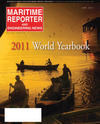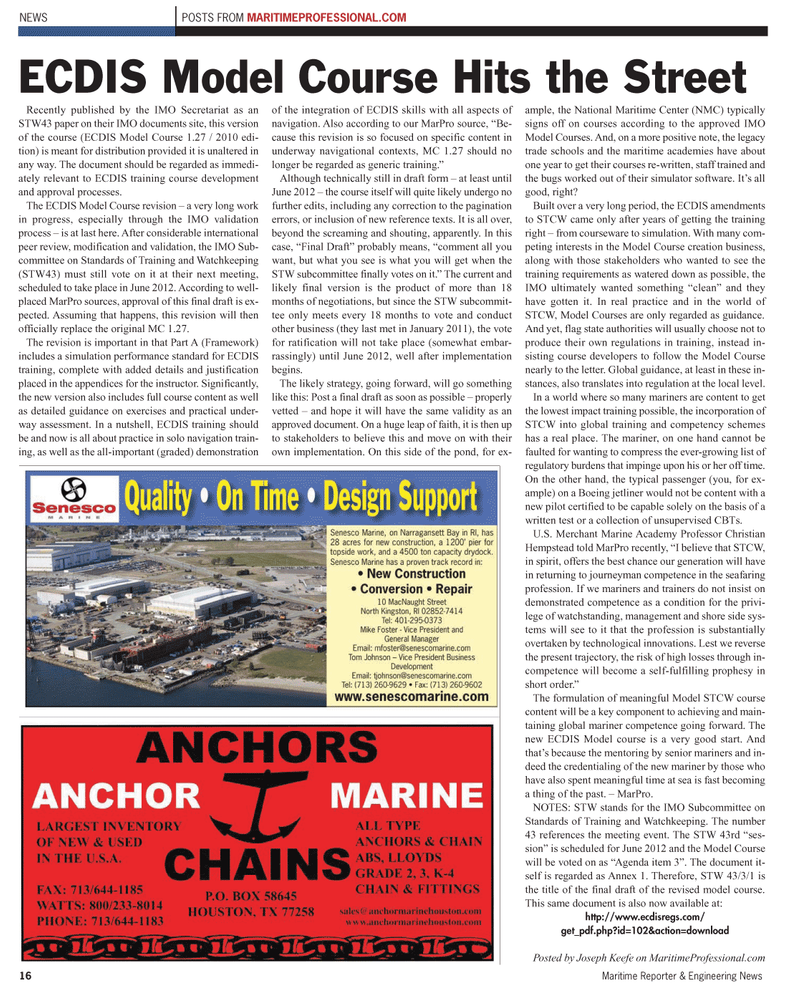
Page 16: of Maritime Reporter Magazine (June 2011)
Feature: Annual World Yearbook
Read this page in Pdf, Flash or Html5 edition of June 2011 Maritime Reporter Magazine
16Maritime Reporter & Engineering News Recently published by the IMO Secretariat as anSTW43 paper on their IMO documents site, this version of the course (ECDIS Model Course 1.27 / 2010 edi-tion) is meant for distribution provided it is unaltered in any way. The document should be regarded as immedi- ately relevant to ECDIS training course development and approval processes. The ECDIS Model Course revision ? a very long work in progress, especially through the IMO validation process ? is at last here. After considerable international peer review, modification and validation, the IMO Sub- committee on Standards of Training and Watchkeeping (STW43) must still vote on it at their next meeting, scheduled to take place in June 2012. According to well- placed MarPro sources, approval of this final draft is ex- pected. Assuming that happens, this revision will then officially replace the original MC 1.27. The revision is important in that Part A (Framework) includes a simulation performance standard for ECDIStraining, complete with added details and justification placed in the appendices for the instructor. Significantly, the new version also includes full course content as well as detailed guidance on exercises and practical under- way assessment. In a nutshell, ECDIS training should be and now is all about practice in solo navigation train- ing, as well as the all-important (graded) demonstrationof the integration of ECDIS skills with all aspects of navigation. Also according to our MarPro source, Be- cause this revision is so focused on specific content in underway navigational contexts, MC 1.27 should no longer be regarded as generic training.? Although technically still in draft form ? at least untilJune 2012 ? the course itself will quite likely undergo no further edits, including any correction to the pagination errors, or inclusion of new reference texts. It is all over, beyond the screaming and shouting, apparently. In this case, Final Draft? probably means, comment all youwant, but what you see is what you will get when the STW subcommittee finally votes on it.? The current and likely final version is the product of more than 18 months of negotiations, but since the STW subcommit- tee only meets every 18 months to vote and conduct other business (they last met in January 2011), the vote for ratification will not take place (somewhat embar- rassingly) until June 2012, well after implementationbegins. The likely strategy, going forward, will go something like this: Post a final draft as soon as possible ? properly vetted ? and hope it will have the same validity as an approved document. On a huge leap of faith, it is then up to stakeholders to believe this and move on with their own implementation. On this side of the pond, for ex- ample, the National Maritime Center (NMC) typicallysigns off on courses according to the approved IMO Model Courses. And, on a more positive note, the legacy trade schools and the maritime academies have about one year to get their courses re-written, staff trained and the bugs worked out of their simulator software. Its all good, right?Built over a very long period, the ECDIS amendments to STCW came only after years of getting the trainingright ? from courseware to simulation. With many com- peting interests in the Model Course creation business, along with those stakeholders who wanted to see the training requirements as watered down as possible, the IMO ultimately wanted something clean? and they have gotten it. In real practice and in the world of STCW, Model Courses are only regarded as guidance. And yet, flag state authorities will usually choose not toproduce their own regulations in training, instead in- sisting course developers to follow the Model Course nearly to the letter. Global guidance, at least in these in- stances, also translates into regulation at the local level. In a world where so many mariners are content to get the lowest impact training possible, the incorporation of STCW into global training and competency schemes has a real place. The mariner, on one hand cannot be faulted for wanting to compress the ever-growing list of regulatory burdens that impinge upon his or her off time. On the other hand, the typical passenger (you, for ex- ample) on a Boeing jetliner would not be content with a new pilot certified to be capable solely on the basis of a written test or a collection of unsupervised CBTs.U.S. Merchant Marine Academy Professor Christian Hempstead told MarPro recently, I believe that STCW, in spirit, offers the best chance our generation will have in returning to journeyman competence in the seafaring profession. If we mariners and trainers do not insist ondemonstrated competence as a condition for the privi- lege of watchstanding, management and shore side sys- tems will see to it that the profession is substantiallyovertaken by technological innovations. Lest we reverse the present trajectory, the risk of high losses through in- competence will become a self-fulfilling prophesy in short order.? The formulation of meaningful Model STCW coursecontent will be a key component to achieving and main- taining global mariner competence going forward. The new ECDIS Model course is a very good start. And thats because the mentoring by senior mariners and in- deed the credentialing of the new mariner by those who have also spent meaningful time at sea is fast becoming a thing of the past. ? MarPro.NOTES: STW stands for the IMO Subcommittee on Standards of Training and Watchkeeping. The number 43 references the meeting event. The STW 43rd ses- sion? is scheduled for June 2012 and the Model Coursewill be voted on as Agenda item 3?. The document it- self is regarded as Annex 1. Therefore, STW 43/3/1 is the title of the final draft of the revised model course. This same document is also now available at: http://www.ecdisregs.com/ get_pdf.php?id=102&action=downloadPosted by Joseph Keefe on MaritimeProfessional.com NEWSPOSTS FROM MARITIMEPROFESSIONAL.COMECDIS Model Course Hits the Street

 15
15

 17
17
